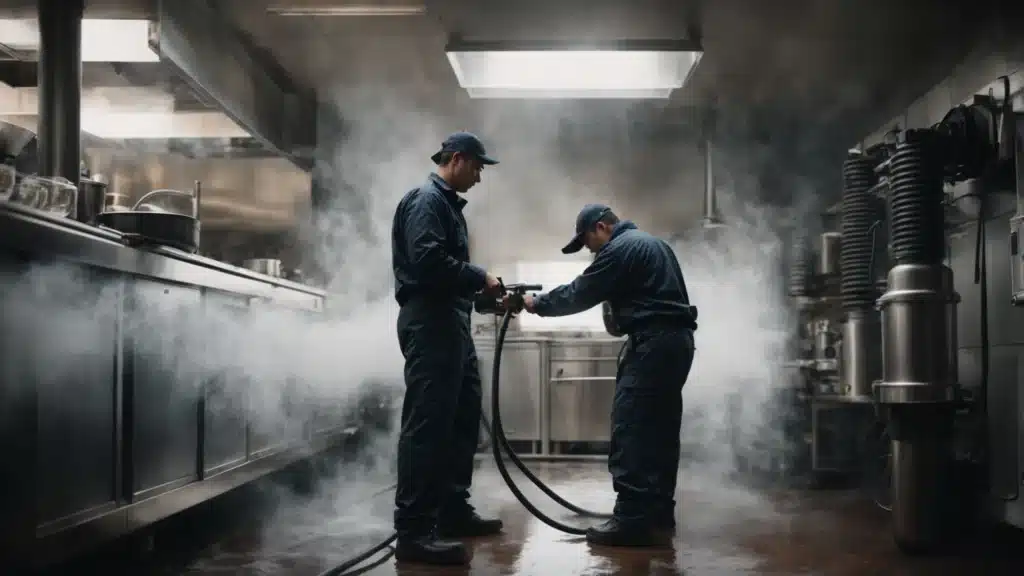Essential Guidelines for Hood and Kitchen Exhaust Maintenance
Best Practices for Hood and Kitchen Exhaust Cleaning:
Maintaining the hood and kitchen exhaust in a commercial kitchen is akin to ensuring a vehicle runs smoothly; it’s critical for both safety and efficiency.
Ignoring the buildup of grease and debris can lead to hazardous working conditions and ultimately impact the food being served.
With a proper understanding and regular maintenance, these issues can be easily avoided, ensuring a clean, safe kitchen that operates at its peak.
Ontario Hood Cleaning stands at the forefront, offering unparalleled services in this essential domain.
Keep reading to take a deep dive into the world of hood and kitchen exhaust maintenance, understanding the essentials, avoiding common pitfalls, and distinguishing between DIY efforts and professional solutions.
Key Takeaways
- Ontario Hood Cleaning Emphasizes the Importance of Professional and Thorough Hood and Kitchen Exhaust Cleaning to Prevent Fire Hazards and Ensure Safety
- Regular Inspections and Maintenance Can Prevent Costly Downtime and Ensure the Kitchen Operates at Peak Efficiency
- Using Eco-Friendly and Potent Degreasers for Cleaning Is Crucial to protecting Equipment Integrity and Comply With Health and Safety Regulations
- A Balanced Approach Between Daily Staff-Led Maintenance Tasks and Professional Cleanings Optimizes Kitchen Safety and Operational Efficiency
- Incorporating Sustainability Into Cleaning Practices, Through Water Conservation and Responsible Waste Disposal, Reflects a Commitment to Environmental Responsibility
Decoding the Basics of Kitchen Exhaust Maintenance
Contact Us
Navigating through the complexities of hood and kitchen exhaust maintenance entails a fundamental understanding of several key factors that can significantly affect the efficiency and safety of Ontario Hood Cleaning commercial kitchens.
At the heart of this journey lies the importance of regular cleanings, a task often undertaken by experts such as Ontario Hood Cleaning, to prevent fire hazards and ensure a clean air environment.
Equally critical is the ability to identify the various components of your kitchen exhaust system and understand their roles.
This knowledge serves as a cornerstone for restaurant owners in assessing the system’s health and pinpointing any potential issues before they escalate.
Furthermore, recognizing the telltale signs that indicate the need for maintenance, ranging from unusual noises to visible grease buildup, is vital.
By staying informed about these aspects, establishments can safeguard their operations against unnecessary risks and downtime.
Understanding the Importance of Regular Cleanings
The imperative of regular cleanings in the maintenance of Ontario Hood Cleaning and kitchen exhaust systems cannot be overstated. Ontario Hood Cleaning emphasizes this practice as essential for removing grease and other flammable residues from the interior surfaces of the hood, filters, ductwork, and exhaust fans. This proactive measure not only mitigates fire hazards but also promotes optimal airflow, contributing to a healthier work environment.
Regular maintenance sessions provide an ideal opportunity to inspect the integrity and functionality of the exhaust system’s components. During these cleanings, professionals from companies like Ontario Hood Cleaning can identify any wear and tear or malfunctioning parts that might compromise the system’s efficiency or safety. Detecting these issues early can save restaurant owners significant time and resources:
- Early detection of faulty components prevents extensive damage.
- Professional cleanings ensure that the system operates at peak efficiency.
- Mitigation of fire risks keeps both staff and patrons safe.
Equipping oneself with the knowledge of when and how often to schedule these cleanings is crucial. The frequency of professional hood and kitchen exhaust cleaning should align with the volume of cooking and the type of food prepared in the establishment. Adhering to local regulations and industry standards, while also considering the specific needs of their kitchen, allows restaurant owners to maintain a safe and compliant environment.
Identifying the Components of Your Kitchen Exhaust
A comprehensive understanding of the components within your kitchen exhaust system is vital for ensuring effective maintenance and operation. The system typically encompasses several key parts, each playing a pivotal role in removing smoke, heat, and grease-laden vapors from your cooking area.
To start, the hood serves as the entry point, capturing contaminants before they infiltrate the air. Following this, filters trap grease particles, preventing them from entering the ductwork. Lastly, the exhaust fan propels the contaminated air outside, maintaining a clean and safe kitchen environment:
- Hood – Captures smoke and vapors
- Filters – Trap grease particles
- Exhaust Fan – Removes contaminated air
Recognizing these components and their function assists restaurant owners and maintenance crews in monitoring their system’s health. It provides a clear outline on what parts require regular cleanings and inspections, guiding establishments towards efficient and safe operations.
Recognizing Signs of Needed Maintenance
Restaurant managers and kitchen staff should be alert to changes in the exhaust system’s performance, as these can signal the need for immediate maintenance. An increase in smoke within the kitchen area, as opposed to it being vented out, typically indicates blockages in the system that need addressing.
Unusual sounds emanating from the exhaust fan, such as rattling or grinding noises, are often signs of mechanical issues. These audible cues should prompt a thorough inspection to prevent future breakdowns and maintain a smooth operation.
Grease accumulation on surfaces around the hood and ductwork is not just a cleanliness concern but also a significant fire risk. Spotting this buildup early on and arranging for professional cleaning can drastically reduce the likelihood of fire hazards in a commercial kitchen setting.
Now that we’ve unlocked the secrets behind kitchen exhaust maintenance, it’s time to roll up our sleeves. Let’s dive into a step-by-step guide to get your hood and exhaust sparkling clean!
Step-by-Step Guide for Cleaning Your Hood and Exhaust
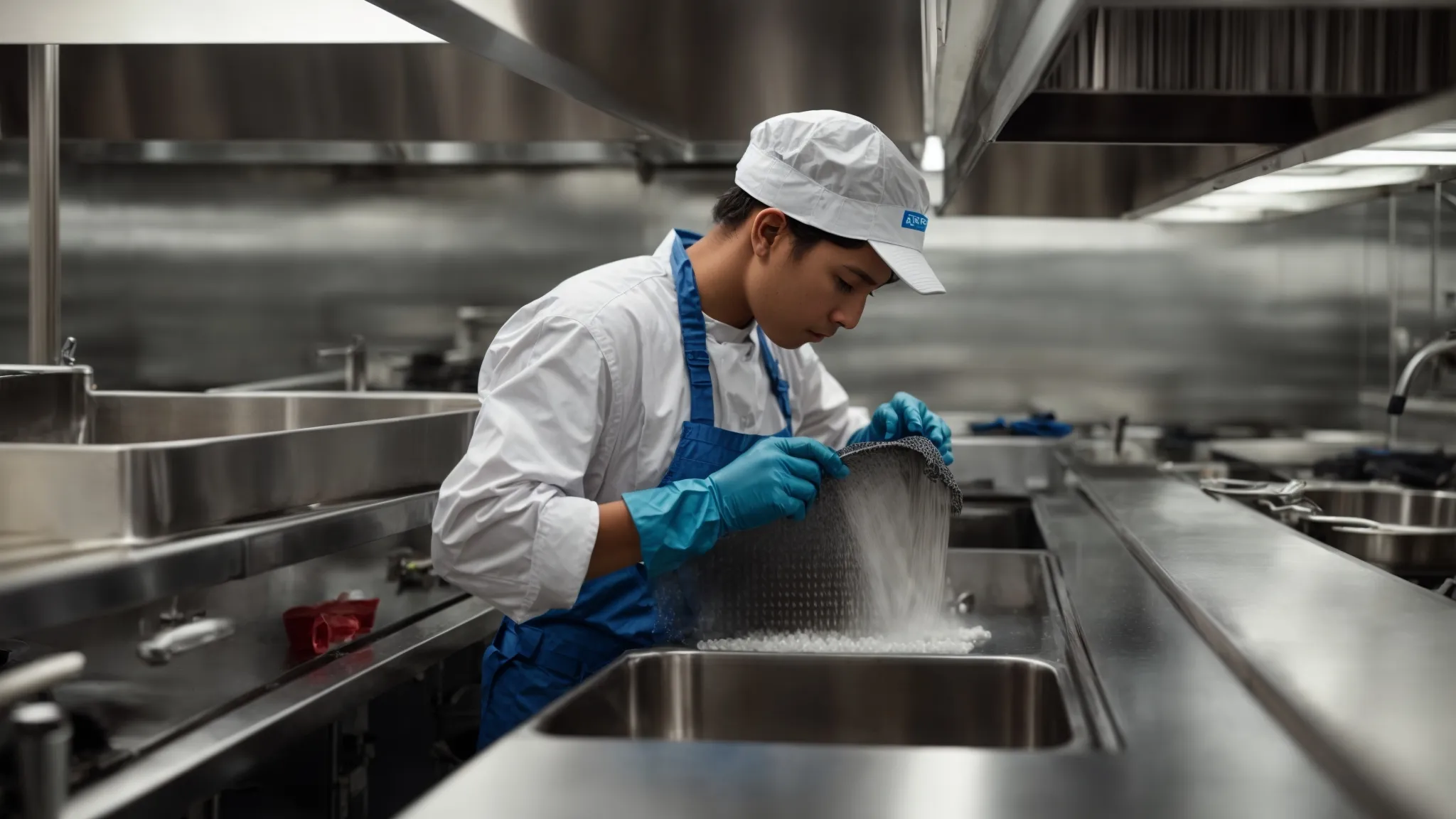
Embarking on the journey of maintaining a clean and efficient kitchen exhaust system begins with understanding and executing a structured cleaning procedure.
This crucial upkeep involves several key steps, starting with the preparation phase, where gathering the appropriate tools and donning safety gear is paramount for ensuring a safe operation.
Equally important is the process of disconnecting power sources before any cleaning commences, safeguarding against electrical hazards.
The focal point of this maintenance task includes a thorough cleaning of the hood filters, a step that demands attention to detail to remove grease and other debris effectively.
Moreover, employing specialized techniques for degreasing the exhaust fans and ductwork is vital for achieving a comprehensive clean, thus enhancing the overall performance and safety of the kitchen exhaust system.
Gathering Necessary Tools and Safety Gear
Before embarking on the meticulous task of cleaning the hood and exhaust in a commercial kitchen, securing the correct tools and safety equipment is a critical first step that should never be overlooked. Establishments like Ontario Hood Cleaning understand that the adequacy of these preparations directly influences the effectiveness and safety of the cleaning process. From high-grade degreasers to long-handled brushes, ensuring each piece of equipment is on hand simplifies the task ahead.
Equally vital is the commitment to personal safety, underscoring the necessity for protective gear during these cleaning operations. Protective goggles shield eyes from potential chemical splashes, while durable gloves guard against harsh cleaning solutions and grease residues that can irritate or damage the skin. This emphasis on safety gear protects not only the individual performing the cleaning but also maintains a safe working environment within the kitchen.
Ontario Hood Cleaning also stresses the importance of utilizing specific equipment designed for kitchen exhaust cleaning to achieve optimal results. Specialized tools such as pressure washers and grease-removal chemicals tailored for commercial kitchen use play a pivotal role in dislodging stubborn grease and grime. By equipping their team with the right tools and safety gear, they set the standard for thorough and efficient hood and kitchen exhaust maintenance, ensuring a level of cleanliness that upholds both hygiene standards and safety regulations.
Disconnecting Power Sources Before Cleaning
Before initiating the cleaning process for the hood and kitchen exhaust systems, one of the most critical steps involves disconnecting power sources. This precautionary measure is fundamental to ensuring the safety of individuals participating in the cleaning operation.
Turning off electrical circuits that power the hood, exhaust fans, and associated lighting prevents the risk of electrical shocks or accidents. Safety should always be the priority during maintenance tasks, particularly when water and chemical cleaning agents are in use:
- Identify and switch off the relevant electrical circuit breakers.
- Unplug any directly connected electrical devices associated with the hood and exhaust system.
- Securely fasten or tag the power disconnection point to inform others that maintenance is in progress.
Adhering to this step not only protects the maintenance crew but also preserves the integrity of the kitchen’s electrical systems. By momentarily disconnecting power sources, Ontario Hood Cleaning ensures a controlled and secure environment for effective hood and exhaust system maintenance.
Detailed Cleaning Process for Hood Filters
The initial step in effectively cleaning hood filters begins with their careful removal from the hood itself. Maintenance professionals, such as those from Ontario Hood Cleaning, emphasize the importance of handling these filters with care to prevent damage or bending. This preparatory action ensures that the cleaning process is both smooth and thorough.
Once removed, the filters are soaked in a solution specifically designed to break down grease and other accumulations without damaging the filter material. This soaking phase, which typically lasts several hours, loosens the grime, making the subsequent cleaning steps much more effective. Ontario Hood Cleaning uses eco-friendly and potent degreasers that are tough on grease but gentle on the filters, promoting both environmental responsibility and material longevity.
Following the soaking period, the cleaning process proceeds with a vigorous scrubbing session. Here, specialized brushes and tools are employed to meticulously cleanse each crevice of the filters, ensuring no residue remains. The professionals at Ontario Hood Cleaning adopt a detailed-oriented approach during this phase, guaranteeing that the filters are restored to their optimal condition, and ready to efficiently trap grease and smoke once reinstalled.
Techniques for Degreasing Exhaust Fans and Ducts
When approaching the degreasing of exhaust fans and ducts, professionals at Ontario Hood Cleaning deploy a combination of experience and specialized equipment. The use of high-powered pressure washers lays the groundwork for the effective removal of caked-on grease and debris, ensuring that every inch of the ductwork is cleaned to the highest standards.
Subsequent to the pressure washing, the application of industrial-strength degreasers comes into play. Ontario Hood Cleaning selects these products carefully, aiming for solutions that cut through the grease swiftly while being safe for both the equipment and the environment. The meticulous application of these degreasers, followed by a thorough rinsing, ensures that the exhaust fans and ducts are free from any hazardous residues.
The concluding phase of the degreasing process focuses on a detailed inspection and drying. Once the cleaning is complete, every component is inspected for any signs of damage or missed spots, guaranteeing a comprehensive clean. Ontario Hood Cleaning’s commitment to excellence is evident in its precision and attention to detail, leaving the kitchen’s exhaust system in pristine condition and operating efficiently.
Mastering the basics of hood and exhaust cleaning sets a solid foundation. Let’s escalate our knowledge by diving into the secrets of scheduling routine maintenance for enduring efficiency.
Scheduling Routine Maintenance for Long-Term Efficiency
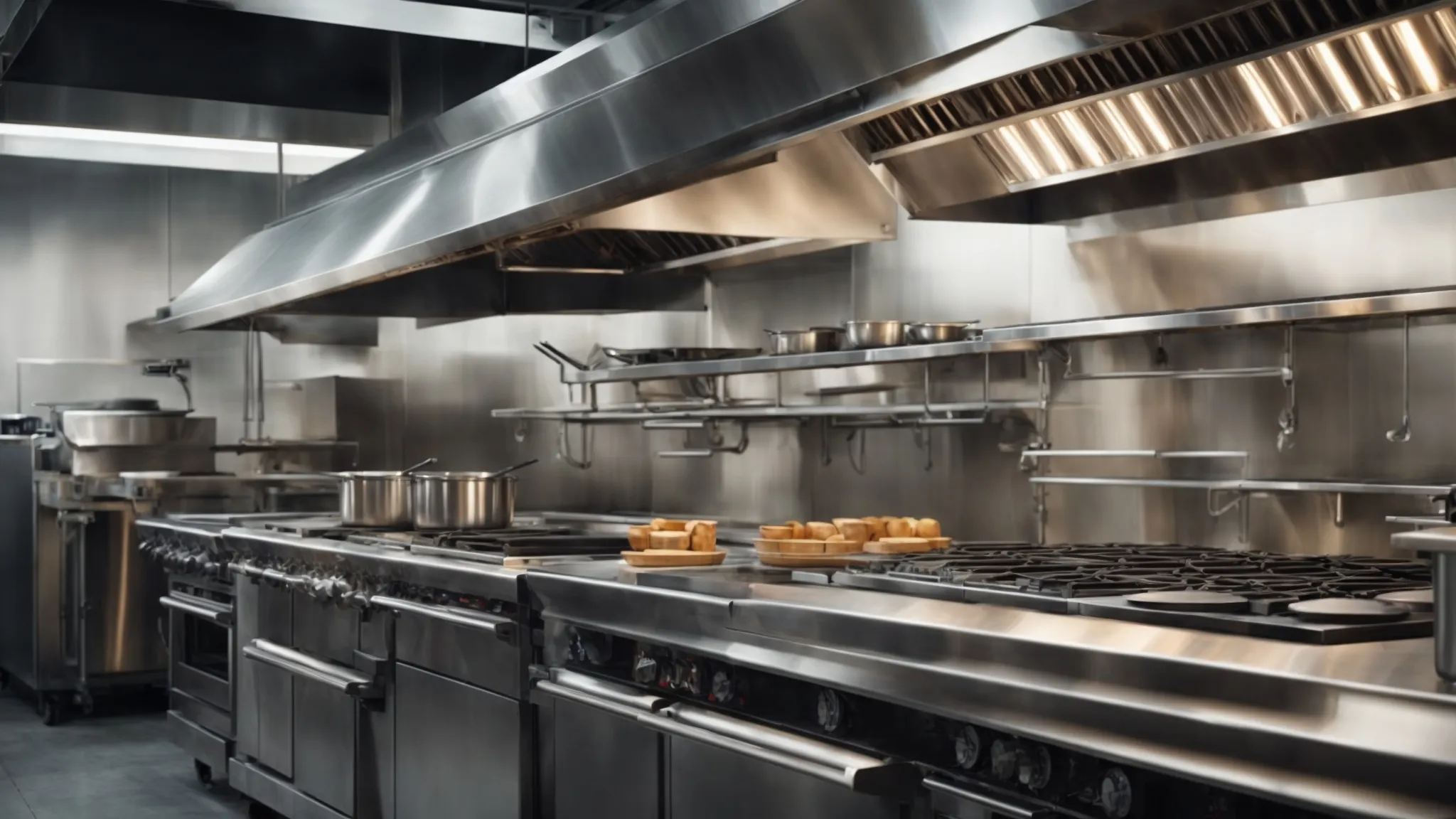
Establishing a systematic approach to hood and kitchen exhaust maintenance is pivotal for securing the longevity and efficiency of these systems.
With the right plan in place, restaurant owners can ensure their kitchens operate within compliance standards while minimizing the risk of unexpected breakdowns.
A critical component of this strategy is developing a cleaning calendar that reflects the volume and type of cooking activities.
Moreover, adhering to recommended professional inspection frequencies ensures that all compliance requirements are met systematically.
In addition to these practices, maintaining a detailed log of all maintenance activities provides valuable insights over time, enabling a proactive rather than reactive approach to kitchen exhaust upkeep.
Developing a Cleaning Calendar Based on Usage
Creating a tailored cleaning calendar for the hood and kitchen exhaust maintenance depends significantly on the specific usage patterns of a commercial kitchen. Establishments that experience heavy volume cooking or those specializing in high grease-producing foods should opt for more frequent cleanings to mitigate the risk of grease accumulation and potential fire hazards.
Ontario Hood Cleaning advises restaurant owners to assess their operational hours and the types of food prepared to determine the optimal cleaning frequency. This assessment not only helps in customizing a maintenance schedule that aligns with the kitchen’s specific needs but also ensures compliance with health and safety regulations.
Engagement with a professional cleaning service like Ontario Hood Cleaning for consultation assists in developing an effective cleaning calendar. Their expertise in hood and kitchen exhaust maintenance allows for a schedule that maximizes kitchen efficiency and safety, tailored precisely to the restaurant’s unique demands.
Professional Inspection Frequencies for Compliance
Maintaining compliance with local health and safety regulations is paramount for any commercial kitchen. This necessitates scheduling professional inspections at frequencies recommended by regulatory bodies. Ontario Hood Cleaning, a leading expert in the field, helps businesses navigate these regulations, ensuring kitchens not only meet but exceed the required standards.
These inspections are designed to thoroughly examine the integrity and cleanliness of hood and kitchen exhaust systems, identifying potential issues before they become hazardous. Ontario Hood Cleaning’s team of professionals leverages their expertise to advise on the optimal times for these inspections, tailored to each restaurant’s specific operations and risk factors.
Adhering to a schedule of routine professional inspections forms the backbone of a proactive maintenance strategy. It’s a critical step in certifying that commercial kitchens operate within the bounds of the law, protecting not just the establishment but also its employees and patrons. With Ontario Hood Cleaning’s guidance, businesses can achieve long-term efficiency and compliance, ensuring their kitchen exhaust systems are always in top condition.
Keeping Maintenance Logs for Future Reference
Maintaining detailed logs of all hood and kitchen exhaust maintenance activities is a practice that Ontario Hood Cleaning strongly advocates for. These records serve as a vital documentation tool, enabling restaurant owners to track the history of cleanings, inspections, and any repairs performed. This systematic recording of maintenance ensures that establishments have a clear understanding of their system’s condition at any given point.
Keeping such maintenance logs also facilitates compliance with health and safety regulations, as these documents can be presented during inspections to demonstrate adherence to required standards. Ontario Hood Cleaning recommends using these logs not only for regulatory purposes but also as a means of identifying patterns that could indicate recurring issues, allowing for preemptive action to be taken.
Moreover, these logs play a crucial role in the planning and budgeting process for future maintenance endeavors. By analyzing past activities detailed in the logs, restaurant owners, with the assistance of Ontario Hood Cleaning, can more accurately forecast when their next service should be scheduled and allocate resources accordingly. This proactive approach to maintenance scheduling minimizes the risk of unexpected system failures and optimizes kitchen operations for long-term efficiency.
Shifting gears from routine maintenance, we dive into a critical territory often overlooked. Sidestepping pitfalls in exhaust upkeep could be your game-changer, ensuring your kitchen runs like a well-oiled machine.
Common Mistakes to Avoid in Exhaust Maintenance
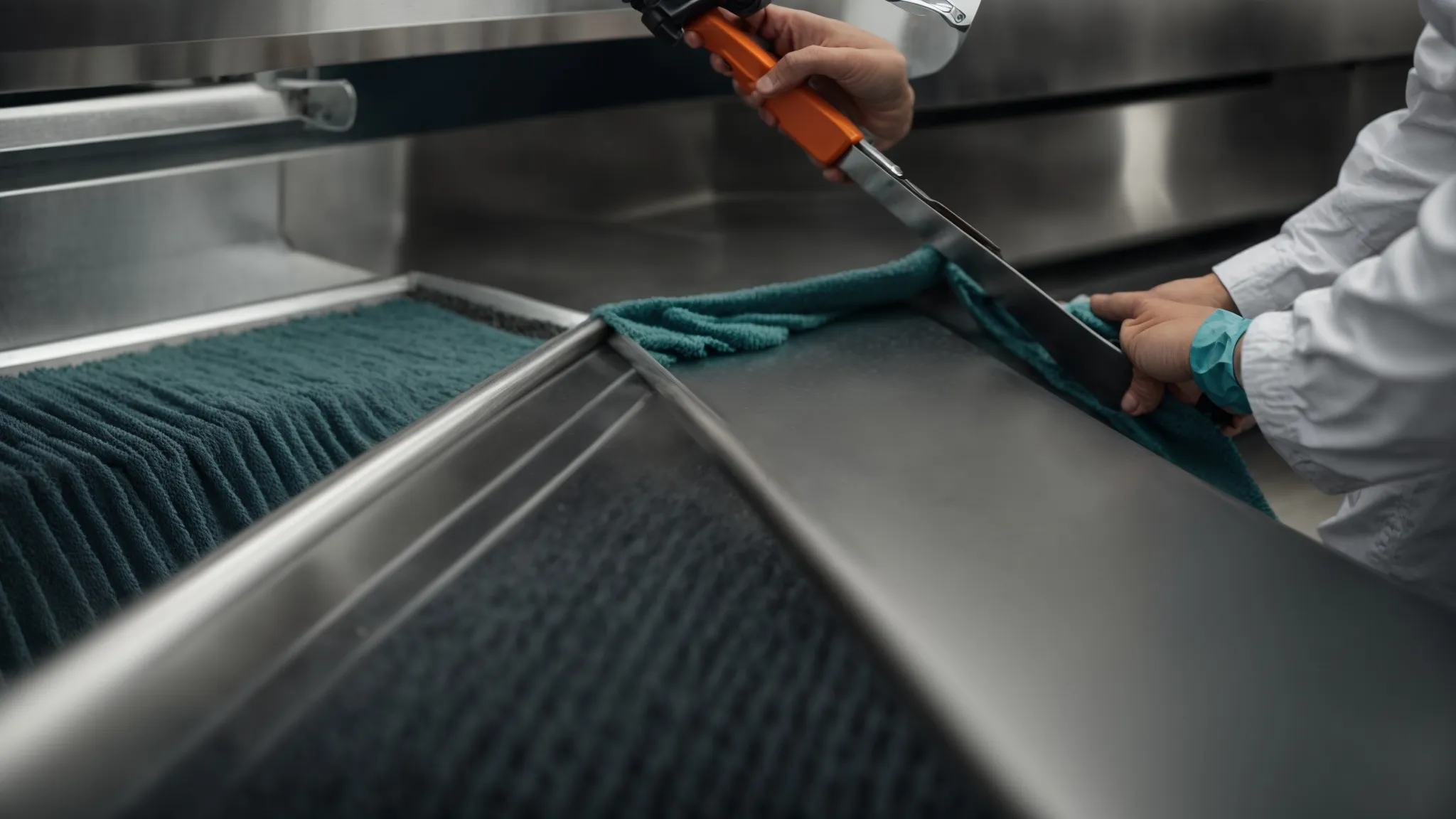
Proper maintenance of hood and kitchen exhaust systems is pivotal in ensuring the safety and efficiency of commercial kitchens.
Despite the best intentions, some common errors can significantly undermine these efforts.
Key among these is neglecting the cleaning of hard-to-reach spaces, which can become hotspots for grease accumulation and fire hazards.
Equally detrimental is the utilization of incorrect or abrasive cleaning solutions that could damage the system components rather than cleaning them effectively.
Moreover, overlooking the necessity for regular inspections and delaying necessary repairs can lead to severe operational disruptions and safety risks.
Addressing these mistakes early can preserve the integrity of exhaust systems, maintaining a safe and compliant kitchen environment.
Overlooking the Cleaning of Hard-to-Reach Areas
A common pitfall in the process of hood and kitchen exhaust maintenance is the neglect of hard-to-reach areas. These spots are often overlooked because they are not easily accessible or visible during routine cleanings. However, their maintenance is critical, as they can accumulate grease and debris, increasing the risk of fire hazards.
Ontario Hood Cleaning emphasizes the importance of addressing every part of the exhaust system, including those hard-to-reach places. Ensuring these areas are thoroughly cleaned can significantly enhance the overall safety and efficiency of the kitchen exhaust system:
| Area | Importance of Cleaning | Risks of Neglect |
|---|---|---|
| Ductwork bends | Prevents grease accumulation | Increased fire hazard |
| Around and behind exhaust fans | Ensures efficient operation | Malfunction or breakdown |
| Interior of exhaust hoods | Reduces airborne contaminants | Lower air quality |
Addressing the cleanliness of these crucial yet often ignored sections demands professional intervention. Ontario Hood Cleaning provides the expertise needed to tackle these challenges, using specialized tools and techniques to ensure a comprehensive and effective cleaning process. By doing so, they help maintain the integrity and functionality of the kitchen’s exhaust system, safeguarding the establishment against potential safety risks.
Using Incorrect or Harmful Cleaning Agents
Opting for the wrong cleaning agents in the process of maintaining hood and kitchen exhaust systems can lead to a series of unforeseen problems. Harsh chemicals, while effective in cutting through grease, may also corrode metal components or deteriorate the filters, compromising the system’s integrity. Ontario Hood Cleaning steers clear of such risks by choosing environmentally friendly yet potent degreasers that safeguard both the equipment and its longevity.
Another issue with using incorrect cleaning solutions is the potential health hazards they pose to kitchen staff and patrons. Toxic fumes emanating from strong chemical cleaners can linger in the air, negatively impacting indoor air quality and potentially leading to health concerns. This is why professionals at Ontario Hood Cleaning prioritize the use of non-toxic and safe cleaning agents, ensuring a health-conscious approach to exhaust maintenance.
Failure to discern the suitable cleaning agents not only affects the physical state of the exhaust system but can also result in non-compliance with local health and safety regulations. Regulatory bodies often have strict guidelines on the types of chemicals that can be used in commercial kitchens. By relying on Ontario Hood Cleaning’s expertise, restaurants ensure that their cleaning practices meet these standards, avoiding potential fines and ensuring a safer working environment.
Neglecting Regular Inspections and Immediate Repairs
One of the pivotal errors in maintaining hood and kitchen exhaust systems is overlooking the need for regular inspections and immediate repairs. Such neglect can allow minor issues to escalate into major concerns, affecting the system’s overall functionality and safety. Ontario Hood Cleaning advocates for preventive measures to avoid costly downtime and ensure uninterrupted operations.
Regular inspections serve as a critical line of defense against potential system failures and safety hazards. Ontario Hood Cleaning’s professional team helps identify and rectify emerging problems, ensuring that all system components work harmoniously. Ignoring this advice can lead to diminished exhaust efficiency, placing undue strain on the kitchen environment.
Immediate repairs, when needed, are not just about fixing current issues but also about safeguarding the future integrity of the exhaust system. Ontario Hood Cleaning emphasizes the importance of addressing repairs without delay to prevent the problems from worsening or causing collateral damage. This approach minimizes the risk of emergency situations, reinforcing the establishment’s commitment to safety and compliance.
Steering clear of those common pitfalls in exhaust maintenance sets the stage for the next crucial choice. Will you grab a toolkit for a DIY adventure, or is it time to call in the pros for a kitchen exhaust cleaning showdown?
DIY vs. Professional Kitchen Exhaust Cleaning

Maintaining the cleanliness and functionality of hood and kitchen exhaust systems poses unique challenges that demand a strategic approach.
While restaurant staff may be able to manage some aspects of maintenance, knowing when to use expert cleaning services is essential for maintaining system integrity and adhering to strict health regulations.
This segment delves into the scenarios where self-conducted maintenance is appropriate, highlights situations that necessitate the expertise of professionals, and outlines the undeniable advantages of enlisting certified cleaning services.
Navigating these distinctions equips restaurant owners with the knowledge to ensure their kitchen exhaust systems operate safely and efficiently.
When to Handle Maintenance Yourself
Understanding when maintenance tasks can be safely and effectively handled in-house is crucial for restaurant owners aiming to maintain a pristine and efficient kitchen environment. For minor day-to-day cleaning tasks, staff members are often able to manage these responsibilities with the proper training and equipment. This strategy not only keeps the kitchen running smoothly but also helps in identifying potential issues that could necessitate professional intervention.
Regular upkeep, such as wiping down the exterior of hoods and ensuring areas around appliances remain grease-free, falls comfortably within the realm of tasks that can be managed without external help. By maintaining these simpler cleaning regimes, establishments can extend the period between professional cleanings, ultimately contributing to a well-maintained and safer kitchen environment:
- Wipe down the exterior hood surfaces daily.
- Keep the areas around cooking equipment free from grease accumulation.
- Inspect and clean the visible parts of the exhaust system as needed.
Moreover, a basic inspection of kitchen exhaust components for visible signs of wear or malfunction allows restaurant staff to act proactively. Reporting these observations to professional cleaners, who can then perform a more detailed evaluation and necessary repairs, ensures minor issues are addressed promptly. This balance between self-directed maintenance and professional services optimizes kitchen safety and operational efficiency.
Situations That Require Professional Attention
Instances when the kitchen exhaust system experiences significant grease buildup require the finesse and expertise of professionals like Ontario Hood Cleaning. This condition surpasses the capacity of regular staff cleanings due to the specialized tools and techniques needed to safely and effectively remove the accumulation.
Another scenario demanding professional intervention is when the exhaust system shows signs of mechanical failure or wear, such as malfunctioning exhaust fans or damaged ductwork. Ontario Hood Cleaning’s team is equipped with the necessary knowledge to diagnose and repair these complex issues, thereby ensuring the system’s optimal operation and compliance with safety standards.
Annual inspections and certifications, mandated by local health and safety regulations, are tasks strictly reserved for certified professionals. Ontario Hood Cleaning provides these services, guaranteeing that commercial kitchens not only meet but exceed regulatory requirements, maintaining a safe environment for both staff and patrons.
Benefits of Hiring Certified Cleaning Services
Enlisting certified cleaning services like Ontario Hood Cleaning provides unparalleled peace of mind to restaurant owners, ensuring that their kitchen exhaust systems meet stringent health and safety standards. These professionals bring a wealth of experience and specialized knowledge to the table, navigating the complexities of hood and exhaust maintenance with ease. Their expertise guarantees a thorough and efficient cleaning process, leaving no stone unturned.
Choosing certified cleaning services equates to investing in long-term operational efficiency. Ontario Hood Cleaning employs cutting-edge techniques and equipment that not only clean but also enhance the performance of kitchen exhaust systems. Their meticulous approach minimizes the risk of future breakdowns and extends the lifespan of the system, reflecting a commitment to both quality and sustainability.
Collaborating with certified professionals ensures compliance with all local regulations, a critical aspect of any commercial kitchen. Ontario Hood Cleaning’s familiarity with the latest health codes and industry standards means that its services go beyond basic cleaning to foster a safe and legally compliant kitchen environment. This understanding safeguards businesses against potential fines and legal issues, reinforcing their reputation and operational continuity.
The journey from DIY to professional hood cleaning illuminates the path to excellence. Let’s elevate the conversation to focus on safety and compliance in exhaust maintenance.
Ensuring Safety and Compliance in Exhaust Maintenance
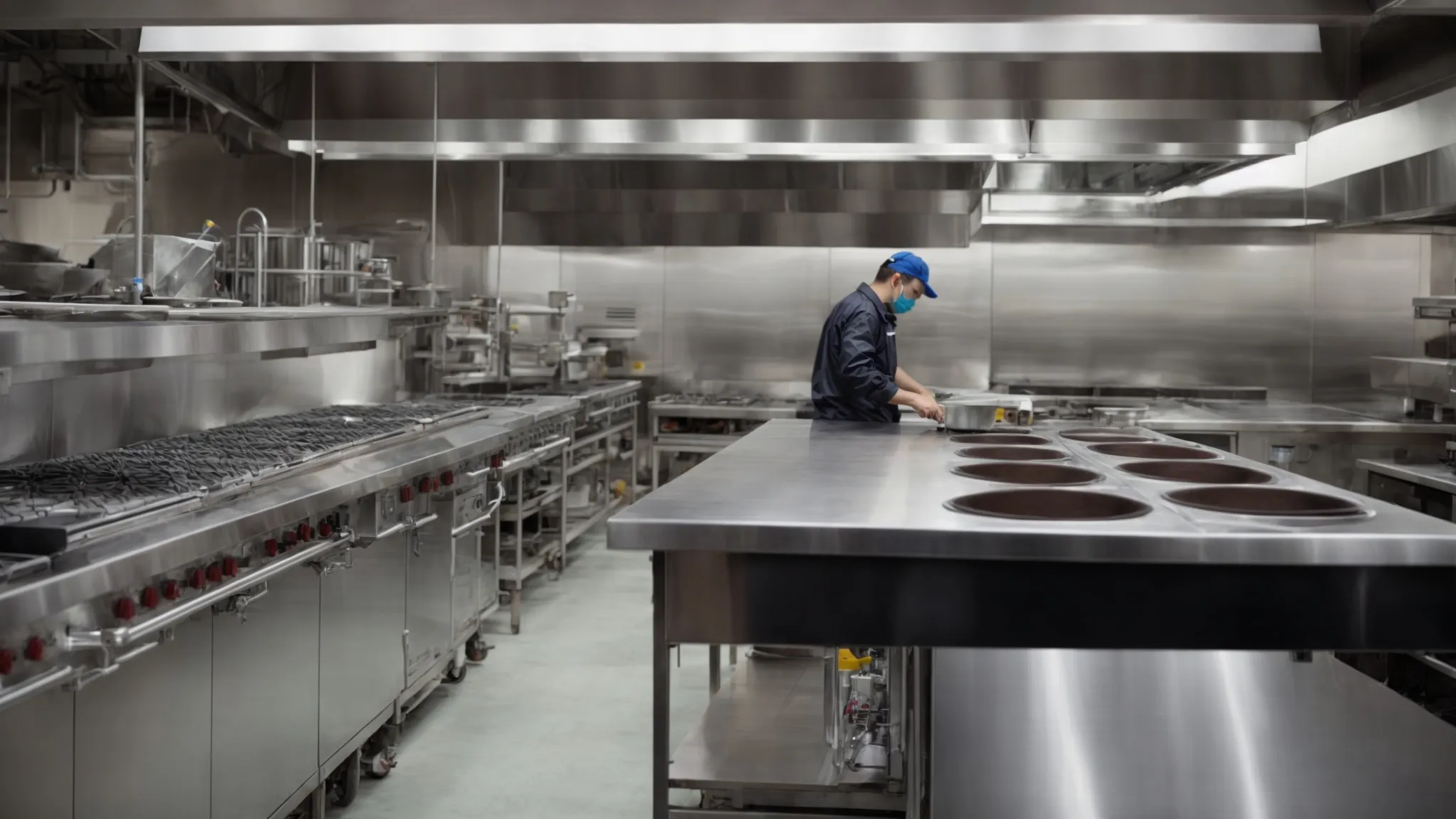
A pivotal aspect of hood and kitchen exhaust maintenance revolves around the essential principles of safety and compliance to protect both personnel and patrons while ensuring operations adhere to legal standards.
This involves a comprehensive approach that includes becoming well-acquainted with local fire safety codes, which serve as a foundation for preventive measures against potential hazards.
Equally imperative is the implementation of fire prevention best practices, a proactive strategy aimed at mitigating risks and enhancing the overall safety of commercial kitchen environments.
Moreover, integrating sustainability into exhaust cleaning practices stands as a testament to a commitment to environmental responsibility, aligning operational processes with eco-friendly principles.
By addressing these components, establishments not only elevate their safety protocols but also contribute positively to industry standards, ensuring a well-rounded approach to exhaust system maintenance.
Familiarizing Yourself With Local Fire Codes
One of the first steps in ensuring a commercial kitchen operates safely is getting acquainted with the local fire codes that pertain to the hood and kitchen exhaust systems. These codes are designed by fire safety authorities to minimize the risk of kitchen fires, a common hazard in the food service industry. Understanding these requirements is vital for restaurant owners and maintenance managers to implement necessary precautions and maintenance routines.
Local fire codes often specify the frequency and method of cleaning for hood and kitchen exhaust systems, emphasizing the removal of grease and other flammable substances. Compliance with these codes not only enhances safety but also ensures that restaurants avoid potential legal repercussions and fines. Ontario Hood Cleaning helps businesses navigate these regulations, providing services that meet or exceed the stipulated standards.
Another crucial aspect involves regular updates and amendments to the fire safety codes, which can impact maintenance practices and schedules. Staying informed about these changes allows restaurant owners to adapt their maintenance strategies promptly, ensuring ongoing compliance. Ontario Hood Cleaning remains abreast of these developments, offering valuable insights and updates through consultations and services tailored to meet these evolving standards.
Implementing Fire Prevention Best Practices
Implementing fire prevention best practices start with a thorough and systematic cleaning of the hood and kitchen exhaust systems. Ontario Hood Cleaning leads this effort by removing all traces of grease and flammable residues, significantly reducing the risk of kitchen fires. This meticulous cleaning process targets every component, ensuring a safe commercial kitchen environment.
Proactive measures extend beyond cleaning, encompassing the inspection and maintenance of fire suppression systems. Ontario Hood Cleaning collaborates with specialists to ensure these critical systems are fully functional and ready to activate in case of a fire. This dual approach combines cleanliness with technological readiness:
| Action | Impact |
|---|---|
| Grease removal from exhaust systems | Minimizes fire hazards |
| Fire suppression system checks | Ensures immediate response capabilities |
Training staff on fire safety protocols and emergency procedures forms the cornerstone of a comprehensive fire prevention strategy. Ontario Hood Cleaning advocates for regular workshops that educate kitchen personnel about the risks associated with grease buildup and the importance of a clean work environment. This educational initiative empowers employees with knowledge and tools to prevent fires, ensuring a culture of safety and vigilance in commercial kitchens.
Incorporating Sustainability in Exhaust Cleaning Practices
Incorporating sustainability into exhaust cleaning practices involves using eco-friendly degreasers and solutions that effectively remove grease without harming the environment. Ontario Hood Cleaning champions this green initiative by selecting products that are both potent against buildup and kind to the planet. This approach not only ensures a thorough clean but also contributes positively to wider environmental goals.
Water conservation is another critical aspect of sustainable kitchen exhaust maintenance. Ontario Hood Cleaning utilizes advanced cleaning techniques that minimize water usage without compromising on quality. By adopting these water-saving methods, they demonstrate a commitment to preserving natural resources while maintaining high standards of cleanliness.
Finally, sustainable practices in hood and kitchen exhaust cleaning extend to waste management. Ontario Hood Cleaning ensures that all grease and debris removed during the cleaning process are disposed of responsibly, adhering to regulations that prevent pollution. This careful attention to disposal methods reinforces their dedication to environmental stewardship, setting a standard for responsible cleaning in the commercial kitchen sector.
Last comments:
Maintaining hood and kitchen exhaust systems is crucial for ensuring the safety, efficiency, and compliance of commercial kitchens.
By adhering to essential guidelines, such as scheduling regular cleanings, identifying and cleaning all system components, and recognizing signs of needed maintenance, restaurant owners can prevent fire hazards and operational disruptions.
Ontario Hood Cleaning highlights the importance of using the right tools, safety gear, and cleaning techniques, as well as the need for professional expertise in handling significant grease buildup, mechanical failures, and regulatory inspections.
Additionally, keeping detailed maintenance logs facilitates proactive management and compliance with health and safety regulations.
Avoiding common mistakes like neglecting hard-to-reach areas or using incorrect cleaning agents ensures the longevity and integrity of the exhaust system.
Ultimately, engaging certified cleaning services guarantees thorough cleaning, and compliance with regulations, and contributes to a safer, more efficient kitchen environment.
Regular updates on fire codes and best practices for fire prevention further enhance safety, while incorporating sustainability practices reflects a commitment to environmental responsibility.

